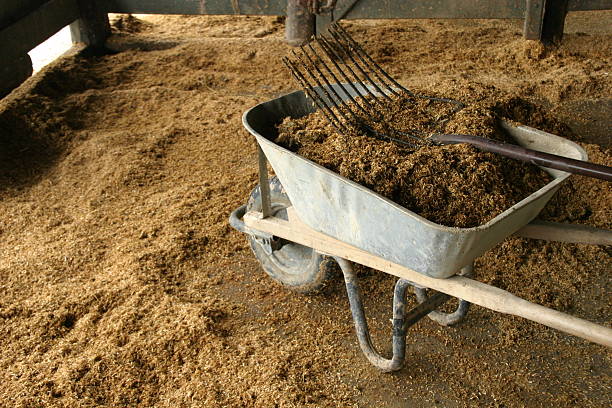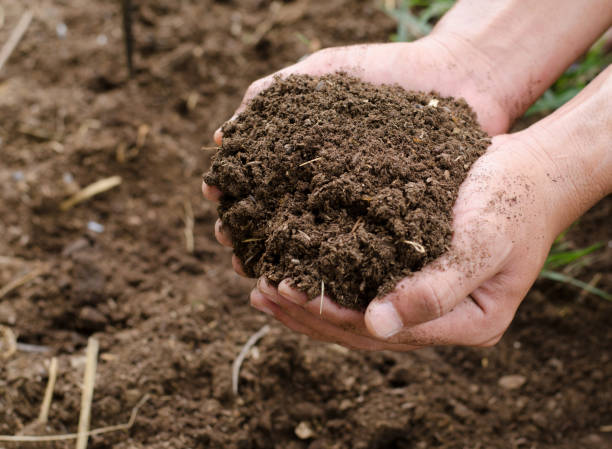Farmyard Manure: What You Can Do With It and The Benefits Of Using Farmyard Manure To Your Garden!
Table of Contents
What is Farmyard Manure?
Farmyard manure is a decomposed mixture of dung and urine from farm animals and litter and leftover material from roughages or fodder fed to cattle used to fertilize the land. It’s a natural fertilizer that can be used in gardens and landscaping. Farmyard manure is high in nitrogen, phosphorus, and potassium, essential nutrients for plants. On average, well-decomposed farmyard manure contains 0.5 percent nitrogen, 0.2 percent phosphorus oxide, and.05 percent potassium oxide. Also, it’s rich in other minerals, such as calcium, magnesium, and potassium.
Farmyard manure can be used as a soil amendment or top dressing on vegetable and flower gardens. When used as a soil amendment, it helps improve the texture and moisture content of the soil. When used as a top dressing, it helps to reduce the need for water, thus saving you money.

Use of Farmyard Manure
FYM should be applied 3 to 4 weeks before planting partially rotten crops. In moist soil, this FYM will decompose and release the nutrients it contains in soluble form, which will benefit the crop’s growth.
The nutrients in FYM are lost to leaching by rainwater if applied too far before sowing the crop. Before planting the crop, work in plenty of well-rotted FYM into the soil.
The best results have come from using FYM on young fruit and vegetable plants. Bone meal (to acid soils) should be used as the base dose, and nitrogenous fertilizers should be applied as a top dressing because FYM contains very little essential nutrient phosphorus.
How to Make A Farmyard Manure
The farmers’ current method of preparing farmyard manure is ineffective and should be changed. It contains one percent nitrogen and 1.35 percent potassium, even though it is thrown away. Urine contains a significant amount of nitrogen, which is mostly in the form of urea, which is subject to volatilization losses. Even during storage, nutrients are lost to leaching and volatilization, which reduces the nutritional value. However, while it is practically impossible to avoid losses altogether, they can be minimized by using a more efficient way of preparing farmyard manure. Trenches ranging in length from 6 to 7.5 meters, in width from 1.5 to 2.0 meters, and depth from 1.0 to 1.5 meters are dug.
Everything that can be used as litter and refuse is combined with soil and spread throughout the shed to absorb urine. After being collected and placed in the trench the following morning, the urine-soaked refuse and dung are disposed of. A section of the trench should be taken up from one end to fill it with the daily collection. A dome is formed at the top of the heap. It is plastered with cow dung earth slurry after being filled up to a height of 45-60 cm above the ground level. The process is repeated until the first trench has been filled, at which point a second trench is prepared.
It takes approximately four to five months after plastering before the manure is ready to be used. Whereas urination is not collected in the bedding, it can be collected in a cemented pit with the washings from the cattle shed, and this waste can then be added to the farmyard manure pit. Farmyard manure can be supplemented with chemical preservatives to help reduce losses and improve the overall quality of the crop. Gypsum and superphosphate are two of the most commonly used chemicals. It is common to spread gypsum in the cattle shed because it absorbs urine and prevents the volatilization loss of urea present in the urine while also adding calcium and sulfur. Superphosphate has a similar effect to phosphate in that it reduces losses while also increasing phosphorus content.
Partially rotten farmyard manure must be applied three to four weeks before sowing, whereas thoroughly rotten manure can be applied immediately before sowing. For most crops, 10 to 20 t/ha is applied; however, more than 20 t/ha may be applied for fodder grasses and vegetables. For the best results, farmyard manure should be used at least 15 days in advance to prevent nitrogen from becoming immobilized. The current practice of leaving manure in small heaps scattered throughout the field for an extended period results in the loss of nutrients. These losses can be minimized by spreading the manure and incorporating it into the soil as soon as possible following application.

Different Methods of Preparation of Farmyard Manure
Pit Procedure
The pit method is recommended for areas with less than 1000 mm of precipitation, while the heap method is recommended for areas with more than 1000 mm of precipitation. It is common practice in FYM to store the waste from cattle sheds in pits that are 2 meters wide, 1 meter deep, and have a sloping bottom toward one end. Spreading straw at a rate of 3-5 kg per animal keeps an absorbent layer at the bottom of the pit. Daily, a 30 cm thick substrate layer containing well-mixed dung, urine, and straw is spread over the absorbent layer, and this process is repeated until the pit is filled. In order to speed up decomposition and remove ammonia, each day’s layer must be compressed, moistened if dry, and covered with a 3-5 cm layer of well-ground fertile soil. Ideally, the pit should be located on higher ground to prevent rainwater entering.
There are no limitations to using FYM in its natural state. Contamination is not an option. Inorganic materials like plastics, metals and dry cells should not be present in the composting pits. The use of heavy metals and plastics must be avoided at all costs. Toxic metals can be found primarily in municipal and industrial waste and subsoil sources.
As an example, Arsenic contamination can be caused by excessive groundwater extraction. Water samples must be taken regularly to check for the presence of contaminants. Farmers use this procedure for commercial purposes. There are typically eight-foot-by-2-foot, 1-meter-deep pits made of dung, urine, and litter filled up to 50 centimeters high. Pits are covered with dry soil. Then mud paste is used for plastering the surface. Approximately 150 to 180 days after plastering two adult animals, the manure was ready for use. Every animal produces about 5 to 6 tons of FYM per year. Typically, 10 to 12 tons of FYM are obtained per pit.
The pit is the only place to make high-quality FYM. Pits of predetermined dimensions must be used to prepare FYM. In pits, the FYM decomposes, and the dosage element is dealt with beneficially. It is the correct way to make FYM.
Gathering of Animals’ Waste- The most important thing is to get rid of animal waste without losing its urine. Then straw, waste food, or the rest of the crop is spread under the animals so that their urine can be absorbed by it. Paddy straw is suitable. 1 kg straw can hold about 1.5 kg urine. The straw rots faster because of this. With a solid floor under the animal, 50 percent of urine can be gathered, and buckets are used to add it to the Farm waste mixed with other waste.
Pit Digging-The size of the will depend on how many animals and how many excrements there are. Only for 3 to 5 animal waste, a pit 6-7 meters long, 1-1.5 kilometers in width, and three meters in depth should be enough. There must be 3 feet of depth from one side of the pit to the other. Put the pit in a place where rainwater can’t get in. Make ridges around the pit.
Pit Filling: There is a low side of the pit that must be filled in first. Then, fill in the rest of the pit up to 1.5 feet above the ground. Then, make a layer of soil 1.5 to 2 inches thick. To make the seeds of farm waste less viable, you should do this. This way, you can keep the dosage elements that are in the waste from the sun.
Number of Pits-After adding soil to the first pit, the farmer should begin filling the second pit, and so on, until the first pit is completely covered. By then, the first pit’s FYM, which was previously tainted by manure, will be ready to be added to the field.
Trench Method
In this step, trenches of 6-8 m length, 1.5-2 m width, and 1-1.25 m depth are made. An end piece of the trench must be taken up to fill with the daily collection. It’s done when the area is filled up to 50 cm above ground level. The top is made into a dome and plastered with cow manure earth slurry.
It is put in layers in these trenches until it is 50 cm above the ground. It is made of a mixture of dung and urine-soaked litter. A layer of 50 cm of soil or wood ash soil is now on top. Then, it is plastered with mud paste. Then, the process goes on. When the first trench is filled, then the second trench is made. About 4-5 months after plastering, the manure is ready to use and used for farming. The manure is ready to use in about 150 to 160 days when the plaster is done.
Heap Method
In this method, each day’s collection from a cattle shed is spread out in the same way until the heap is at least 1meter above the ground. With dung and mud mix, the top of the heap is made to look round. In both the heap and pit methods, aeration is allowed in the beginning. Later, anaerobic conditions set in and last for a long time. After 5 to 6 months, the manure is ready to use and spread on the ground.
These methods must start before the rainy season and be used all year long. If you keep your animal’s manure in the right way, it could be as much as 4-5 tons of manure per year that contains 0.5% nitrogen. In contrast to 1-2 tons per animal per year with 0.5% nitrogen made by the indigenous method. The materials must not have any heavy metal in them.
People who work on farms use this method the most. It takes a lot of time and effort to keep the sweepings, cow dung, and other waste that people leave at the same place every day. After about 6 to 9 months, the rotten manure is put to good use again. 30-35 percent N2 and 20-25 percent P2O5 and 4-6 percent potassium are lost due to leaching, washing, and volatilization when manure is made before it is put on the farm.
Increasing the Quality of Farmyard Manure
The most common organic fertilizer used on crops is farmyard manure. Maintaining an active soil life requires a high percentage of organic material, supporting soil organisms. In the first year after farmyard manure is applied to soil, about half of its nutrient content becomes available for crop growth. The remaining nutrients are released after being transported by soil biotic processes. Having a lot of organic matter and much active soil life helps keep the soil structure loose. In addition, the cation exchange capacity, infiltration rate, and the risk of soil pests will all be improved by this method. After drying for two or three days, farmers bring the manure out of their sheds and spread the dried manure in small piles on the field before incorporating it into the soil.

Factors Influencing FYM’s Nutritional Buildup
- Growing animals and milking cows excrete the age of animal-All, the nutrients given to plants, but the nitrogen and phosphorus retained in these animals’ systems are not enough to support their growth and milking functions. On the downgrade, animals expel more waste and body tissue than they consume.
- Feed-Feed high in plant food ingredients results in a more enriched excreta.
- Nature of the Litter Applied-Nitrogen was added to manure through cereal straw, and leguminous plant refused as litter.
- Manure’s Natural Decomposition-With age, the manure becomes more nutrient-dense and less bulky.
When to Apply Farmyard Manure?
Farmyard manure is typically applied in the spring and autumn because it takes time to break down and release nutrients while also acting as a layer of protection against cold and wet weather.
It takes time for the entire amount of nutrients present in farmyard manure to become available. The first crop has access to approximately 30% of the available nitrogen, 60 to 70% of the available phosphorus, and 70% of the available potassium.
Application of Farmyard Manure
Soil fertility is improved by applying farmyard manure. It has a dramatic positive impact on soil’s physical, chemical, and biological properties.
FYM should be applied evenly and thoroughly mixed into the soil. It must be applied 15-20 days before transplanting or sowing to allow manure to ammonify and nitrify. It is not permitted to use undecomposed manure.
The soil must be sufficiently moist at application. It ensures good microbial activity. The typical application rate ranges from 2 to 5 tons per acre for most crops. However, vegetables, sugarcane, and other crops may reach 50 to 100 tons per acre. It should be powdered and sieved for the best response, especially for nursery use.
Farmyard manure application has been shown to keep soil productivity longer than inorganic fertilizer applications. FYM contains all of the macronutrients and micronutrients needed for plant growth, but nitrogen, phosphorus, and potassium have the most impact. Also important for improving soil nutrient and structural status is preserving organic matter in the soil. FYM regulates the dynamics of all macronutrients and micronutrients in addition to its nutritional role.
Benefits of Manure
In light of the preceding, you might conclude that using farmyard manure is a quaint practice in the modern era of space exploration. However, the results of experiments with high-quality products demonstrate that it is the yardstick by which all other organic manures are measured. It is also a humus supplier. For every ton of compost you purchase, you will receive approximately 3 to 5 cwt of organic matter, which will decompose in the soil and provide all of the benefits associated with humus over time. A single dressing’s benefits can last for three or more years because it provides nutrients in a slowly absorbed form. Single dressing can last for up to three or more years.
Advantages of Farmyard Manure
- They provide essential nutrients to plants, including micronutrients that help improve the quality of gardens and crops.
- It is organic and has no added chemicals.
- They enhance the physical properties of the soil, such as its structure and water holding capacity.
- Nitrogen is the main component, but because of its larger, cloddier form, it can also be used as mulch to protect against harsh weather, retain moisture, and provide drainage. Its natural components are released into the soil as microbial activity breaks it down.
- They increase nutrient availability and make them more fertile.
- Carbon dioxide is a CO2 fertilizer that is released during decomposition.
- To a certain extent, parasitic nematodes and fungi on plants can be controlled by altering the balance of soil microorganisms.
Disadvantages of Farmyard Manure
- In the process of decomposition, it releases toxic gases into the atmosphere.
- Reduces the number of certain micronutrients that are readily available.
- Farmyard manure necessitates more nutrients per unit weight during transportation, storage, and use than fertilizer does.
Plants Favorable to Farmyard Manure
Vegetable crops such as potato, tomato, sweet potato, carrot, radish, onion, and similar crops respond favorably to farmyard manure. Sugarcane, rice, napier grass, orchard crops such as oranges, bananas, mangoes, and plantation crops such as coconut are among the other responsive crops.
